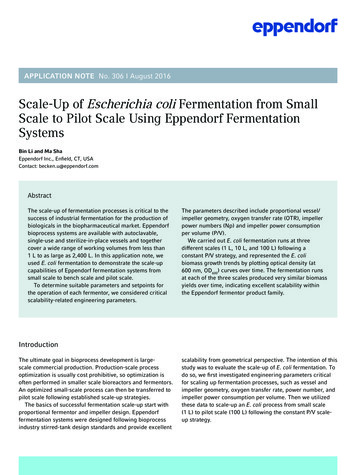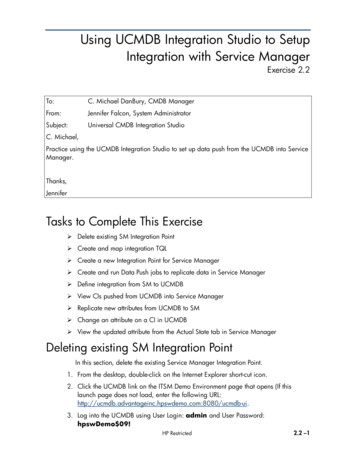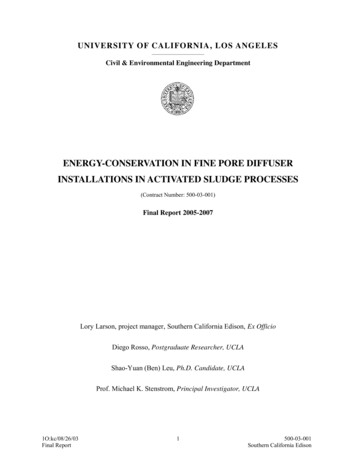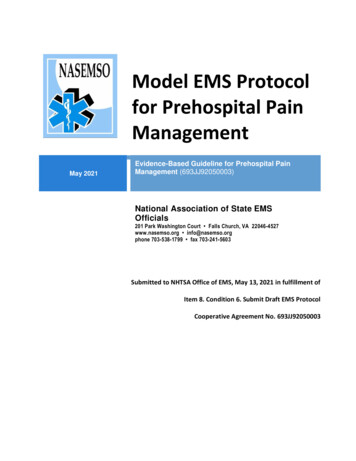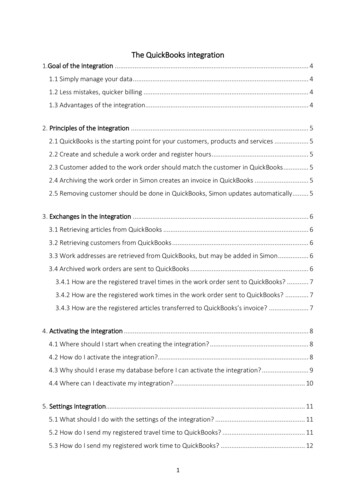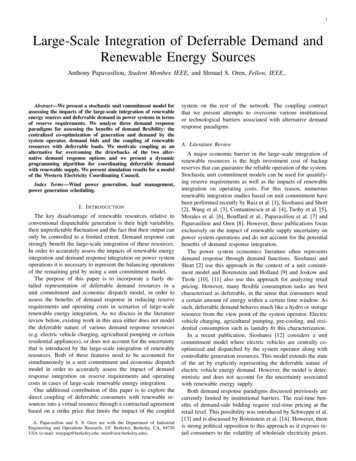
Transcription
1Large-Scale Integration of Deferrable Demand andRenewable Energy SourcesAnthony Papavasiliou, Student Member, IEEE, and Shmuel S. Oren, Fellow, IEEE,,Abstract—We present a stochastic unit commitment model forassessing the impacts of the large-scale integration of renewableenergy sources and deferrable demand in power systems in termsof reserve requirements. We analyze three demand responseparadigms for assessing the benefits of demand flexibility: thecentralized co-optimization of generation and demand by thesystem operator, demand bids and the coupling of renewableresources with deferrable loads. We motivate coupling as analternative for overcoming the drawbacks of the two alternative demand response options and we present a dynamicprogramming algorithm for coordinating deferrable demandwith renewable supply. We present simulation results for a modelof the Western Electricity Coordinating Council.Index Terms—Wind power generation, load management,power generation scheduling.I. I NTRODUCTIONThe key disadvantage of renewable resources relative toconventional dispatchable generation is their high variability,their unpredictable fluctuation and the fact that their output canonly be controlled to a limited extent. Demand response canstrongly benefit the large-scale integration of these resources.In order to accurately assess the impacts of renewable energyintegration and demand response integration on power systemoperations it is necessary to represent the balancing operationsof the remaining grid by using a unit commitment model.The purpose of this paper is to incorporate a fairly detailed representation of deferrable demand resources in aunit commitment and economic dispatch model, in order toassess the benefits of demand response in reducing reserverequirements and operating costs in scenarios of large-scalerenewable energy integration. As we discuss in the literaturereview below, existing work in this area either does not modelthe deferrable nature of various demand response resources(e.g. electric vehicle charging, agricultural pumping or certainresidential appliances), or does not account for the uncertaintythat is introduced by the large-scale integration of renewableresources. Both of these features need to be accounted forsimultaneously in a unit commitment and economic dispatchmodel in order to accurately assess the impact of demandresponse integration on reserve requirements and operatingcosts in cases of large-scale renewable energy integration.One additional contribution of this paper is to explore thedirect coupling of deferrable consumers with renewable resources into a virtual resource through a contractual agreementbased on a strike price that limits the impact of the coupledA. Papavasiliou and S. S. Oren are with the Department of IndustrialEngineering and Operations Research, UC Berkeley, Berkeley, CA, 94720USA (e-mail: tonypap@berkeley.edu; oren@ieor.berkeley.edu).system on the rest of the network. The coupling contractthat we present attempts to overcome various institutionalor technological barriers associated with alternative demandresponse paradigms.A. Literature ReviewA major economic barrier in the large-scale integration ofrenewable resources is the high investment cost of backupreserves that can guarantee the reliable operation of the system.Stochastic unit commitment models can be used for quantifying reserve requirements as well as the impacts of renewableintegration on operating costs. For this reason, numerousrenewable integration studies based on unit commitment havebeen performed recently by Ruiz et al. [1], Sioshansi and Short[2], Wang et al. [3], Contantinescu et al. [4], Tuohy et al. [5],Morales et al. [6], Bouffard et al., Papavasiliou et al. [7] andPapavasiliou and Oren [8]. However, these publications focusexclusively on the impact of renewable supply uncertainty onpower system operations and do not account for the potentialbenefits of demand response integration.The power system economics literature often representsdemand response through demand functions. Sioshansi andShort [2] use this approach in the context of a unit commitment model and Borenstein and Holland [9] and Joskow andTirole [10], [11] also use this approach for analyzing retailpricing. However, many flexible consumption tasks are bestcharacterized as deferrable, in the sense that consumers needa certain amount of energy within a certain time window. Assuch, deferrable demand behaves much like a hydro or storageresource from the view point of the system operator. Electricvehicle charging, agricultural pumping, pre-cooling, and residential consumption such as laundry fit this characterization.In a recent publication, Sioshansi [12] considers a unitcommitment model where electric vehicles are centrally cooptimized and dispatched by the system operator along withcontrollable generation resources. This model extends the stateof the art by explicitly representing the deferrable nature ofelectric vehicle energy demand. However, the model is deterministic and does not account for the uncertainty associatedwith renewable energy supply.Both demand response paradigms discussed previously arecurrently limited by institutional barriers. The real-time benefits of demand-side bidding require real-time pricing at theretail level. This possibility was introduced by Schweppe et al.[13] and is discussed by Borenstein et al. [14]. However, thereis strong political opposition to this approach as it exposes retail consumers to the volatility of wholesale electricity prices.
2In addition, real-time prices often fail to convey the economicvalue of demand response due to the non-convex costs ofsystem operations. This effect has been reported by Sioshansi[2], who notes that the failure of real-time prices to capturenon-convexities induces a dispatch of deferrable resources thatresults in excessive startup and minimum load costs. Thecentral co-optimization of demand-side resources, renewablesupply and generator dispatch discussed by Sioshansi [12]represents the most efficient approach for exploiting demandside flexibility. However, this paradigm cannot be implementedin practice as the system operator dispatches the system ata bulk scale and cannot control individual retail loads. Inaddition, the optimization problem is too complex to solve.An alternative demand response paradigm that is not discussed in this paper has been set forth by Hirst and Kirby[15] and Kirby [16], whereby flexible loads deliver servicesto the ancillary services market. According to this paradigm,an aggregator bids on behalf of load aggregations for providing ancillary services to the system operator. The aggregator coordinates aggregate consumption by a price-based ordirect control method. The technical feasibility of demandside aggregation for the provision of spinning reserve hasbeen studied in practice by Eto [17]. As ancillary servicesrequirements are expected to increase due to renewable energyintegration, this solution could prove lucrative for users whowould be willing to respond to the instantaneous needs ofpower system operators. However, there are concerns aboutdefining market products that correspond to the types ofservices that loads can actually offer, which raises the needfor reform in existing electricity markets.A stream of literature with a focus on strategic demand-sidebidding in unit commitment models has been developed byLamont and Rajan [18] and Zhang et al. [19]. Such modelstypically involve a utility owning both generation assets aswell as own demand, where the utility strives to optimizemarket bids while accounting for uncertainty in competitors’bids as well as the impact of its own bids on market prices.A literature review is provided by David and Wen [20]. Thisliterature focuses on strategic interactions among bidders andis therefore not explored further in this paper.B. Paper ContributionsThe methodological contribution of this paper is to presenta stochastic unit commitment model that can be used in orderto quantify the benefits of deferrable demand in mitigating theincreased operating costs and day-ahead reserve requirementsresulting from the random fluctuation of renewable energysupply. The use of stochastic planning models for simulatinglong-term market equilibrium in order to quantify generationinvestment in the face of long-term uncertainty was recentlyintroduced by Ehrenmann and Smeers [21]. Analogously, thestochastic unit commitment model presented in this paper isused in order to simulate the two-stage operation of dayahead and real-time electricity markets. The use of a stochasticunit commitment model for the purpose of simulating theoperations of a day-ahead market introduces computationalchallenges that can be addressed by using an appropriatescenario selection technique to discretize the uncertainty spaceof the problem [22], [23], [24], [5] and exploiting the decomposable structure of the resulting stochastic optimizationproblem [25], [26], [27], [28], [3], [29]. These computationalchallenges have been addressed in previous work by theauthors [7], [8] and will not be the focus of this paper.The modeling contribution of this paper is to simultaneously incorporate deferrable demand response resources andstochastic renewable supply resources in the stochastic unitcommitment and economic dispatch models. The demandbidding models cited earlier [10], [11], [14], [2] do not accountfor inter-temporal elasticities, thereby making demand appearindependent across time periods. In the present paper we highlight the inadequacy of this approach in representing deferrabledemand. On the other hand, the work of Sioshansi [12] doesnot account for the uncertainty introduced by renewable energysupply and inflexible demand fluctuations. In this paper weextend existing models by simultaneously modeling the intertemporal dependency of deferrable demand and renewablesupply uncertainty.The third and final contribution of this paper is to present acontractual alternative for coupling the operations of renewableresources with deferrable demand that attempts to overcomethe implementation barriers associated with centralized loaddispatch and real-time pricing of retail loads, and compare therelative performance of each demand response paradigm interms of system operating costs. The motivation of directlycoupling renewable generation with deferrable demand is tocreate a net resource or load that appears ‘behind the meter’from the point of view of the system operator, thus limitingthe risk that the system operator needs to offset by procuringreserves.The California ISO provides a representative example of theinstitutional and regulatory difficulties that render coupling apragmatic approach to the large-scale integration of demandresponse. The Board of Governors of the California ISOrecently appraised the current status of integrating distributedresources, including demand response, in the California ISOenergy market [30]. The presentation and executive summaryjustify, in detail, why the market-based integration of demandresponse is far from foreseeable, which justifies the couplingapproach that the authors present in this paper for overcomingexactly these institutional difficulties. The most that the California ISO can expect currently from distributed resources arerough estimates that can be incorporated into load forecastsbut not direct accounting of demand response in the dispatchor unit commitment of the system [30].The remaining paper is organized as follows. In Section IIwe provide an overview of the components of our model. InSection III we describe in detail the demand flexibility modelsthat we consider in our analysis. Results from a test case ofthe Western Electricity Coordinating Council are presented inSection IV. In Section V we discuss the conclusions of ourwork.II. M ODEL OVERVIEWIn Fig. 1 we present a diagram of a stochastic unit commitment model that accounts both for the fluctuations of
3Fig. 1.Overview of the model.renewable supply as well as the benefits of demand responsein absorbing these fluctuations. Uncertainty in the model isdriven by renewable supply and demand. Demand resources inthe system are categorized as inflexible (firm) consumers withstochastic consumption patterns and deferrable consumers thatrequire a fixed amount of energy within the day and adapttheir instantaneous consumption patterns to the prevailingsystem conditions. The model of Fig. 1 serves two purposes.The decision support module in the upper portion of thefigure simulates day-ahead market operations and is used fordetermining day-ahead reserve requirements when deferrabledemand contributes to absorbing the variability of renewableenergy supply. The evaluation module in the lower portion ofthe figure uses the reserves committed by the day-ahead modelin order to compare the real-time operating costs of the systemunder the three demand response paradigms that are discussedin the introduction of the paper. In what follows we describeeach component of the model in further detail.A. Statistical ModelsThe stochastic unit commitment model presented in SectionII-B which is used for determining the optimal amount ofreserves in the system accounts for firm demand and renewablesupply uncertainty. We use a second order autoregressivemodel for modeling demand and load. We assume that firmdemand and renewable production are independent in thestochastic unit commitment model.Our analysis in this paper focuses on wind power resources.Due to the nonlinear relation of wind speed to wind power,we develop a stochastic model of wind speed and use anappropriately calibrated static power curve to determine thecorresponding wind power production. We employ a dataset published by the National Renewable Energy ResourcesLaboratory (NREL) which provides hourly time series of windspeed at various geographic locations over a year. In orderto calibrate our wind speed model to the available data, wefirst remove seasonal and diurnal patterns, and subsequentlytransform the data set in order to obtain a strictly stationaryGaussian data set. The autoregressive parameters of the strictlystationary data set are estimated using the Yule-Walker equations. Our methodology follows Brown et al. [31], Torres etal. [32] and Callaway [33]. The calibration and simulationprocedure and the fit of the model to the available data setis presented in Papavasiliou and Oren [34]. The calibrationof firm demand follows as a special case, since the strictlystationary data set that is obtained after removing seasonaland diurnal patterns is already approximately Gaussian. Thefit of the stochastic demand model to the data is shown in Fig.2.In the present analysis we use a single-area wind model andignore transmission constraints in order to focus on the impactof demand response. The effect of transmission constraints in asystem with multi-area renewable supply and demand responsewill be addressed in future work. The problem of balancingthe schedules of coupled resources with the rest of the systemwhile respecting transmission constraints would be addressedby the system operator and would be reflected in locationalmarginal prices from the point of view of aggregators. In theframework of a nodal market any transaction is exposed tocongestion charges that the aggregator can hedge by buyingfinancial transmission rights (FTRs) [35].B. Stochastic Unit CommitmentIn order to determine the day-ahead reserves that are committed by the system operator in order to accommodate thesimultaneous integration of renewable supply and deferrabledemand, we formulate a unit commitment model which assumes that the system operator co-optimizes the dispatch
4Fig. 2.Probability distribution function of inflexible demand.of flexible loads and generation resources. The uncertaintystemming from renewable supply and load fluctuations isrepresented in terms of a discrete set of scenarios S. Thestochastic unit commitment model is formulated as a two-stagedecision model where the first stage represents day-ahead unitcommitment and the second stage represents real-time economic dispatch in the hour-ahead market, in hourly intervals,subsequent to the realization of uncertainty. As we illustrate inFig. 1, we use this model to determine the day-ahead scheduleof slow reserves assuming that the system operator can cooptimize the dispatch of generators and deferrable loads.(SU C)X:X Xminπs (Kg ugst Sg vgst Cg pgst )(1)g G s S t Ts.t.Xpgst Dst est , s S, t T(2)g GXest R, s S(3)t T0 est C, s S, t T(4)ugst wgt , vgst zgt , g Gs , s S, t T(5)(p, e, u, v, w, z) D.(6)The set of generators G in the system is partitioned intoa set of slow generators Gs for which commitment decisionsare fixed in the day-ahead time frame, and fast generators thatcan adjust their commitment schedule in the second stage.This approach is inspired by the work of Ruiz et al. [1],and adopted by Papavasiliou et al. [7]. First-stage decisionswgt , zgt represent the binary unit commitment and startupdecisions for slow generators. The second-stage decisionsinclude the unit commitment, startup and power output of allgenerators, denoted respectively as ugst , vgst and pgst . Thedispatch of deferrable loads is also a second-stage decisionvariable denoted as est . The objective function of Eq. (1)minimizes operating costs. Startup costs, minimum load costsand constant fuel costs for each generator g are denotedrespectively as Sg , Kg and Cg . The model is solved for a24-hour horizon with hourly time steps. Power balance isenforced in Eq. (2). The net demand Dst , which is the netof firm demand minus renewable power supply, representsthe source of uncertainty. The constraint of Eq. (3) requiresthat deferrable loads be supplied an amount of energy Rwithin a given time window and Eq. (4) enforces a limit ofC on the consumption (e.g. charge) rate of deferrable loads.The non-anticipativity constraints on first-stage decisions isenforced in Eq. (5). Note that all generators, including slowunits, can adjust their production level in the second stage.The set D includes generator capacity constraints, rampingconstraints, and minimum up and down times, where boldfonts indicate vectors. The notation of the stochastic unitcommitment model and the economic dispatch models that arepresented subsequently is summarized in the appendix. Thesolution of the stochastic unit commitment model is describedin detail by Papavasiliou [36].The scenario selection algorithm used in the stochastic unitcommitment model of this paper is inspired by importancesampling, whereby scenarios are selected according to theireffect on expected cost and weighed such that their selectiondoes not bias the objective function of the stochastic unitcommitment formulation. The decomposition algorithm whichis employed relies on a Lagrangian relaxation scheme forscenario decomposition. Both the scenario selection algorithmand decomposition algorithm developed by the authors accountfor transmission constraints, load uncertainty and renewablesupply uncertainty as well as generator and transmissionline outages [7], [8]. However, transmission constraints andelement outages are not accounted for in this paper in orderto isolate the effect of demand response on absorbing theuncertainty of renewable energy supply.The centralized stochastic unit commitment model presented in this section presumes the ability of the systemoperator to centrally monitor and control individual loads. Thisis unrealistic in practice due to technological and institutionalreasons. Nevertheless, such a centralized model provides auseful benchmark for estimating the maximal potential benefitsof demand response, and the efficiency losses of decentralizingdemand response through load aggregators. For this reason,such a centralized demand response model has been previouslyemployed in the literature [12].The aggregate load represented in Eqs. (2) - (4) can beperceived as a collection of a large number of identical deferrable loads that place identical requests for energy demand,are characterized by the same power rating and share powerconsumption equally across the entire population. In futureresearch the authors intend to exploit high performance computing in order to incorporate a more detailed representationof deferrable loads according to their energy demand, capacityrating, and availability for charge.In order to draw a comparison between the operating costimpact of the three demand response policies discussed in thispaper, we use a single stochastic unit commitment model inorder to model day-ahead market interactions. As a result,there is a misrepresentation of recourse as far as the alternativedemand response models are concerned. In effect, the firststage reserve commitment decisions are somewhat overoptimistic, in assuming that the system operator can centrally
5coordinate generation and demand response resources. Theprice of this simplification is that we are obtaining a lowerbound on the performance of demand response, a pessimisticassessment of how different demand response strategies willperform. As a result, we are able to isolate the effect of demandresponse on operating costs and draw a consistent comparisonamong different demand response paradigms.III. D EMAND F LEXIBILITYIn this section we describe each of the three demandresponse paradigms that were discussed in the introduction andhow these are integrated in the economic dispatch model ofreal-time operations. The optimal unit commitment and startup?schedules wgt, zgtdetermined by the optimal solution of thestochastic unit commitment model in the day-ahead phaseare used as input to an economic dispatch model for eachrealization of uncertainty ω. As in the case of the stochasticunit commitment model, the horizon T of the problem is 24hours in hourly time steps.A. Centralized Load ControlIn the centralized load control approach we assume that thesystem operator co-optimizes the dispatch of flexible loads andgeneration resources:(EDω ) : minXX(Kg ugt Sg vgt Cg pgt )(7)g G t Ts.t.Xpgt Dωt et , t T(8)g GXet R(9)t T0 et C, t T(10)?ugt wgt, vgt zgt, g Gs , t T(11)(p, e, u, v) D.(12)periods and a time-varying stochastic intercept that dependson the realization of inflexible demand.In order for the demand function model to be consistent withthe two alternative demand response models, we calibrate thedemand function parameters so that they satisfy the followingtwo conditions: the demand functions have to yield a total dailydemand of R subject to the charging rate constraint C, andthe demand functions have to be consistent with the observedinflexible demand in the system. The calibration process issummarized in the following steps:Step (a). Select the fraction of inflexible demand α suchthat R represents a fraction 1 α of total daily demand.In particular, given R, the fraction α for each day type isR, where D̄ is the average dailydetermined as 1 α R D̄firm demand for each day type, as estimated from the availabledata.Step (b). Set the slope b such that the supply to priceresponsive consumers equals R in the economic dispatchmodel with slow generator schedules fixed according to the?optimal solution wgt, zgtof (SU C). In particular, we proceedby fixing the demand functions at the point (λR , D̄αt ) andcalibrating the demand function slope b until the deterministicunit commitment model corresponding to an average windpower supply profile results in a total demand D̄α . Here D̄tcorresponds to the average hourly firm demand forPeach daytype as estimated from the available data, and D̄ t T D̄t .Step (c). For each realization ω resulting in inflexibledemand αQt (λR ; ω), set at (ω) Qt (λR ; ω) bλR in orderto be consistent with the observed inflexible demand.Step (d). The inverse demand function for deferrable deqtmand is given by Bt (qt ; ω) 1b (at (ω) 1 α), qt C.We can then discretize the inverse demand function to obtainvaluations Blt for the set of price-responsive loads L andinclude these valuations in a welfare maximization formulationof the economic dispatch model:XX(EDω ) : maxBlt dltl L t TXX (Kg ugt Sg vgt Cg pgt )Despite the fact that the centralized model is not realisticin practice, it is useful for providing a benchmark for thepotential benefits of demand flexibility. In this formulation,Dωt represents the net of firm demand minus renewablesupply.g G t Ts.t.Xpgt Dωt g GXdlt , t T(15)l L0 B. Demand BidsXdlt C, t T(16)l LThe demand model that we present in this section is basedon Borenstein and Holland [9] and Joskow and Tirole [10],[11]. We assume a linear demand function that consists of afraction α of inflexible consumers who face a fixed retail priceλR , and a fraction 1 α of price-responsive consumers whoface the real-time price of electricity λt . The demand functionQt (·) for each period can therefore be expressed as:Qt (λt ; ω) at (ω) αbλR (1 α)bλt ,(14)(13)where at (ω) is the intercept and b is the slope of the demandfunction. Note that we assume a common slope for all time?ugt wgt, vgt zgt, g Gs , t T(17)(p, e, u, v) D,(18)where dlt represents the power draw of load segment l inperiod t. As in the case of the centralized demand responsemodel in Section III-A, Dωt represents the net of firm demandminus renewable supply.C. CouplingHere we consider a contractual arrangement for couplingrenewable suppliers with deferrable loads. According to such
6a contract, an aggregator is entitled to any amount of output from a large group of renewable generation assets upto its loading capability. The aggregator then enters into acontractual agreement to supply deferrable loads. Loads arecharacterized by a fixed amount of energy demand within afixed time window. The aggregator controls the loads directlyand uses renewable resources as the primary energy sourcefor satisfying deferrable demand. In the case of renewablesupply shortage, the aggregator resorts (to a limited extent)to the real-time wholesale market for procuring power at theprevailing price. The aggregator compensates deferrable loadsat a rate ρ for each unit of unserved energy. The setup is similarto dynamic scheduling [15], whereby demand and supplyresources from different control areas pair their schedules inorder to produce a zero net output to the remaining system.Such scheduling is currently implemented in the ERCOTmarket.For practical purposes we do not envision the load aggregator as becoming a trader of renewable power. We therefore assume that the aggregator has the option to consumerenewable energy but not ownership over the renewable energyoutput. The aggregator can then schedule as much load as ithas against the renewable supply but has no title against theresidual. Effectively, the aggregator is holding a “use it or loseit” contract for the renewable supply output.1) Implementation: As Schweppe et al. [13] discuss, theoperating cost benefits of incorporating demand flexibility inpower systems are expected to be outweighed by the savingsin capital investment on balancing generation capacity. Suchsavings can be ensured, in the context of coupling contracts,by limiting the participation of aggregators in the real-timewholesale market. It is therefore necessary to provide financialincentives to deferrable loads for limiting their consumption toan efficient level that ensures the satisfaction of their demandwhile not imposing excessive capacity requirements on thesystem. Priority pricing introduced by Chao, Wilson, Oren andSmith [37], [38] and the derivative idea of callable forwardcontracts introduced by Gedra and Varaiya [39], and extendedby Oren [40] can be used for limiting the participation ofdeferrable loads in the real-time market, while compensatingloads for the capacity savings they enable. Callable forwardcontracts bundle a forward contract on power supply with acall option that can be exercised by the system operator inreal time in order to limit the consumption of deferrable loadswhenever real-time price exceeds a strike price k. Callableforward contracts therefore enable flexible consumers to enterthe merit order stack of the system operator at the price k,which translates to capacity savings for the system operator.It is important to ensure that callable forward contracts,or other mechanisms for inducing deferrable loads to limitthe degree of their participation in real-time markets, induceloads to self-select the degree of their participation in the realtime market efficiently. In particular, it is desirable to providestrong financial incentives for loads to limit their participationin the real-time market to the greatest possible extent, withouthowever making these financial incentives so strong as todistort allocative efficiency. In the context of callable forwardcontracts, this translates to inducing loads to self-select thelowest strike price k that still provides sufficient flexibility fordeferrable loads to participate in the real-time market in orderto satisfy their entire demand.2) Problem Formulation: The coupling contract that wedescribed in the previous section can be formulated as astochastic optimal control problem. The aggregator solves thefollowing:min E[µt (xt )Xλt (µt (xt ) wt ) t ρrN ],(19)t Ts.t.r1 R(20)µt (xt ) wt Mt(21)0 µt (xt ) C(22)where µt (xt ) represents the rate at which power is suppliedto deferrable loads. The state vector xt (λt , wt , rt ) consistsof the real-time price λt , the available renewable powersupply wt and the remaining energy demand of the deferrableconsumers rt . The initial condition for the residual demandis r1 R, where R is the amount of energy demand tobe satisfied. The control µt (xt ) is constrained by the rate ofsupply C and by the amount of energy that can be procuredin the real-time electricity market Mt , which is a randomvariable. T
Engineering and Operations Research, UC Berkeley, Berkeley, CA, 94720 USA (e-mail: tonypap@berkeley.edu; oren@ieor.berkeley.edu). system on the rest of the network. The coupling contract that we present attempts to overcome various institutional or technological barriers associated with alternative demand response paradigms. A. Literature Review
